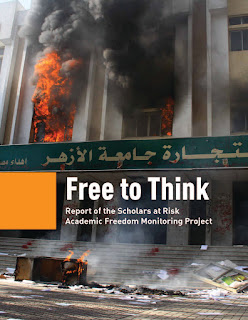It is true enough that the attacks, especially by vanguard elements of the political class, have been seeking to eliminate the substantive elements of academic freedom as they have come to be understood and applied in developed States. The United States provides an important battleground, for example in the recent actions of the political sector in Wisconsin (e.g., here).
But these battles pale in comparison to attacks on academic freedom in other parts of the world, some of which can make things quite dangerous, physically as well as professionally, for faculty. These are monitored by the folks at Academic Freedom Monitor. It is maintained by Scholars at Risk, an international network of institutions and individuals working to promote academic freedom and to protect higher education communities worldwide.
For those interested I have included links to a new report produced by the Scholars at Risk Academic Freedom Monitoring Project, Free to Think (June 2015; ISBN 978-0-692-45867-9). The Release Statement noted:
The report calls on all stakeholders, including the international community, states, the higher education sector, civil society and the public at large to undertake concrete actions to increase protection for higher education communities, including documenting and investigating attacks, and holding perpetrators accountable.
SAR invites you to download and share the report with your networks over social media. Use the hashtag #Free2Think and join the conversation!
The Press Release, Forward and Table of Contents follow:
In its Web Press Release, Scholara at Risk explained:
At the United Nations Palais des Nations in Geneva, Switzerland, Scholars at Risk released Free to Think, the first report of its kind demonstrating the alarming frequency and scope of attacks on scholars, students and other members of higher education communities worldwide.
The report, which culminates four years of monitoring and reporting from SAR staff and researchers around the world, analyzes 333 attacks on higher education arising from 247 verified incidents in 65 countries between January 2011 and May 2015.
“Attacks on universities and colleges are occurring with alarming frequency,” says Rob Quinn, SAR's Executive Director. “We hope this report will inspire everyone to do more to protect higher education and the freedom to think,” says Mr. Quinn.
Scholars at Risk Academic Freedom Monitoring Project, Free to Think
(June 2015; ISBN 978-0-692-45867-9)
FOREWORD
Scholars at Risk (SAR) works to promote academic freedom and protect the human rights of higher education communities worldwide. An international network of institutions, associations and individuals, Scholars at Risk has provided over the last 15 years advice and direct assistance to institutions and scholars in over 2000 cases, including arranging over 600 positions of sanctuary for scholars forced to flee their home countries due to violence and threats. Scholars at Risk also advocates for scholars facing prosecution, imprisonment or other restrictions through the SAR Scholars-in-Prison Project, and raises awareness about threats to higher education communities through the SAR Speakers Series, faculty development workshops, the biennial SAR Network Global Congress and the SAR University Values bulletin. The SAR Academic Freedom Monitoring Project is a natural extension of these activities. Having worked with scholars from over 100 countries, Scholars at Risk has observed patterns in the attacks against the higher education sector. The persistence of these patterns suggest that we can —we must—do more to prevent the attacks that necessitate direct assistance in the first place. Moreover, many of the attacks experienced are not remedied by simply relocating the targeted scholar: one individual may be removed from harm, but the period of respite may only be temporary and many others may remain in physical danger or with their education and academic freedom rights at risk. The monitoring project therefore is a complement to ongoing direct assistance to individuals, raising awareness of the problem with the aim of preventing and deterring future attacks. We hope this report will inspire everyone to do more to protect higher education, including reporting incidents and demanding greater security for higher education communities, accountability for perpetrators, and support for victims. We hope it will help to relieve the debilitating pressures of isolation and self-censorship in academic communities around the world, by letting administrators, scholars, students and staff know that they are not alone; the world is watching. Finally, we hope that it will encourage more institutions and individuals to join Scholars at Risk, to support our work, and to become a vital part of protecting scholars, promoting academic freedom and defending everyone’s freedom to think, question and share ideas.
TABLE OF CONTENTS
Foreword ......................................................................................................................5Executive Summary .....................................................................................................9
Killings, Violence &
Disappearances............................................................................................................14
Wrongful Prosecution & Imprisonment.......................................................................20
Loss of Position
& Expulsion from Study .............................................................................................24
Restrictions on Travel or .Movement..........................................................................26
Other Incidents ...........................................................................................................30
Recommendations ......................................................................................................32
Appendix: Methodology ............................................................................................35
Appendix: Table of Incidents......................................................................................36

No comments:
Post a Comment